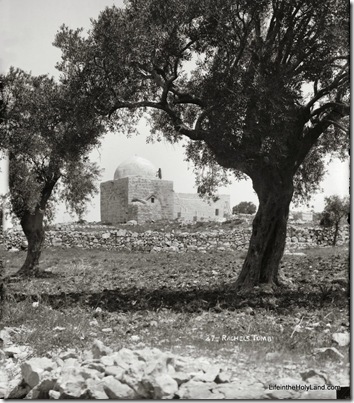The traditional location of the tomb of Jacob’s beloved wife is located on the north side of Bethlehem, next to the main highway that has run from Jerusalem to Hebron for thousands of years now. The photo below gives a good idea of what the monument looked like in the early 1900s. It’s quite picturesque.
Today, it’s a little harder to get a photo (see below). The tomb is here, just behind that fortified IDF watchtower on the right. The ancient highway now has “walls reaching up to heaven,” and Joshua himself might have despaired of getting through.
The reason for such security is that the tomb is a holy site for some religious Jews, but the Arab city of Bethlehem has grown up around the tomb. When the Israelis built the partition wall, they designed its route so that the tomb and the road accessing it would stay on the Israeli side of the wall. In difficult days, even this protection is not enough and travel to the tomb is banned. The Palestinians who live next to the tomb can no longer cross the street.
Looking for a bright spot in all of this? How about this: the tomb has nothing to do with Rachel anyway. According to 1 Samuel 10:2, her tomb was in the tribal territory of Benjamin, which begins five miles north along the Hinnom Valley of Jerusalem. So all this expense and rancor is over Jews who want to pray at what likely was originally the tomb of a Muslim holy man!
The top photo is one of more than 550 photos included in the Southern Palestine volume of The American Colony and Eric Matson Collection (Library of Congress, LC-matpc-09188). For less than 4 cents a photo ($20/CD), you get a unique and outstanding collection of high-resolution photographs of Bethlehem, Hebron, the Shephelah, Tell Beit Mirsim, the Judean wilderness, Jericho, the Jordan River, the Dead Sea, Masada, Qumran, and the Negev.


2 thoughts on “Rachel’s Tomb, Then and Now”
"According to 1 Samuel 10:2, her tomb was in the tribal territory of Benjamin, which begins five miles north along the Hinnom Valley of Jerusalem. So all this expense and rancor is over Jews who want to pray at what likely was originally the tomb of a Muslim holy man!"
While I'm open to skepticism, I am curious about the full details. Genesis 35:19 identifies her grave site as "on the road to Ephrath, which is Beth Lehem". Can this be in the Binyamin location? If there is any discrepancy between those identifications, have there been attempts to explain it?
Assuming there is no contradiction, whose word are the two sides taking for the identification of the site? The Muslim claim that the site is the "Bilal ibn Rabah", not kever Rahel, dates back a full nine years. I'm guessing that the 1700-year Jewish claim was probably staked "officially" by Rabbi Yitzhak Luria, i.e. the Ari z"l. Of course, such a claim would be taken on faith, as would the claim that this is simply a Muslim burial place. (I took some info from http://www.jcpa.org/JCPA/Templates/ShowPage.asp?DBID=1&LNGID=1&TMID=111&FID=442&PID=0&IID=1923)
Michael – good question. I've written more about this in a brief article that I will send you directly by email.